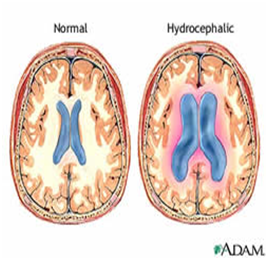
Definition: – hydrocephalus is the abnormal accumulation of the CSF in the intracranial space. It occurs due to imbalance between production and absorption of CSF or due to obstruction of the CSF pathway. It results in dilatation of the cerebral ventricles and enlargement of the head.
Etiology: – it may occur due to congenital or acquired-
Congenital hydrocephalus-
Intrauterine infection, brain tumor obstruction, intracranial hemorrhage, malformation of arachnoid villi etc.
Acquired hydrocephalus-
Inflammation, trauma, neoplasm, hypervitaminosis A, connective tissue disorder, arterio-venous malformation etc.
Types: – there are mainly two types-
Communicating hydrocephalus:-
There is no blockage between ventricular system, the basal cisterns & the spinal subarachnoid space. There may be failure in the absorption of CSF or excessive production of CSF as in choroid plexus papiloma, pseudotumor, etc.
Non-communicating hydrocephalus:-
There is obstruction at any level in the ventricular system, commonly at the level of aqueduct or at foramina luschka and or magendie. The obstruction may be partial, intermittent or complete. It develops mainly due to inflammation and developmental obstructive lesions.
Pathophysiology:-
The ventricular system becomes greatly distended and dilated
Increase intaventricular pressure leads to thinning of cerebral cortex and cranial bones
Ependymal lining of ventricles is disrupted resulting in periventricular ooze
Sub-ependymal edema occurs edema occurs and white matter is compressed
Downward bulging of third ventricle compresses the optic nerves and hypophysis cerebri with dilation of sella turcica
Cortical atrophy may also occur
Clinical features:-
• Excessive enlargement of head
• Delayed closer of anterior fontanel
• Open sutures
• Increased intracranial pressure and alteration in muscle tone
• Delayed head holding in infants
• Protruding forehead
• Shiny scalp with prominent scalp vein
• Sun-set sign of eyes
• Cracked pot sign
• Increased head circumference
• Convulsions personality changes etc.
Diagnostic evaluation:-
• CT scan
• MRI
• USG
• Encephalography
• X-ray
MANAGEMENT:-
Directed Towards:-
a. Relief of hydrocephalus or reduce the intracranial pressure
b. Prevention or management of complications
c. Managing problems caused by the pathology
There are several types of shunts which performed in hydrocephalus:-
Ventriculoatrial Shunt Placement
Lumboperitoneal Shunt Placement
Ventriculoperitoneal Shunt Tap
Ventriculopleural Shunt Placement
Ventriculoatrial Shunt Placement
Ventriculoureteric Shunt Placement







